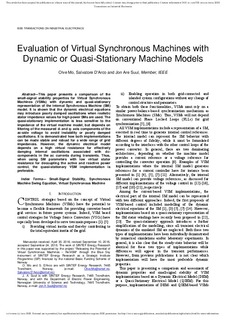| dc.contributor.author | Mo, Olve | |
| dc.contributor.author | D'Arco, Salvatore | |
| dc.contributor.author | Suul, Jon Are Wold | |
| dc.date.accessioned | 2017-02-07T14:53:39Z | |
| dc.date.available | 2017-02-07T14:53:39Z | |
| dc.date.created | 2017-02-03T08:25:21Z | |
| dc.date.issued | 2016 | |
| dc.identifier.issn | 0278-0046 | |
| dc.identifier.uri | http://hdl.handle.net/11250/2429847 | |
| dc.description.abstract | This paper presents a comparison of the small-signal stability properties for Virtual Synchronous Machines (VSMs) with dynamic and quasi-stationary representation of the internal Synchronous Machine (SM) model. It is shown that the dynamic electrical equations may introduce poorly damped oscillations when realistic stator impedance values for high power SMs are used. The quasi-stationary implementation is less sensitive to the impedance of the virtual machine model, but depends on filtering of the measured d- and q- axis components of the ac-side voltage to avoid instability or poorly damped oscillations. It is demonstrated how both implementations can be made stable and robust for a wide range of grid impedances. However, the dynamic electrical model depends on a high virtual resistance for effectively damping internal oscillations associated with dccomponents in the ac currents during transients. Thus, when using SM parameters with low virtual stator resistance for decoupling the active and reactive power control, the quasi-stationary VSM implementation is preferable. | nb_NO |
| dc.language.iso | eng | nb_NO |
| dc.publisher | IEEE | nb_NO |
| dc.title | Evaluation of Virtual Synchronous Machines With Dynamic or Quasi-Stationary Machine Models | nb_NO |
| dc.type | Journal article | nb_NO |
| dc.type | Peer reviewed | nb_NO |
| dc.rights.holder | IEEE | nb_NO |
| dc.source.journal | IEEE transactions on industrial electronics | nb_NO |
| dc.identifier.doi | 10.1109/TIE.2016.2638810, | |
| dc.identifier.cristin | 1446424 | |
| cristin.unitcode | 7548,50,0,0 | |
| cristin.unitname | Energisystemer | |
| cristin.ispublished | true | |
| cristin.fulltext | postprint | |
| cristin.qualitycode | 2 | |
